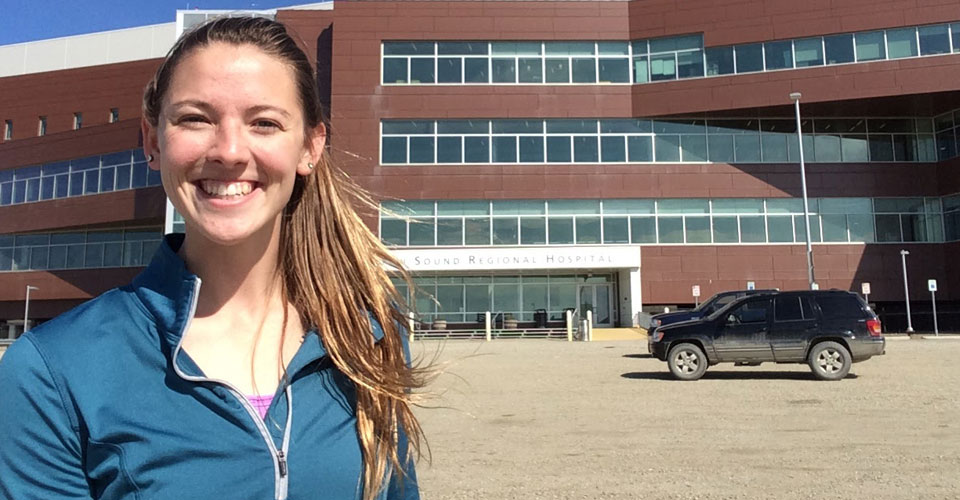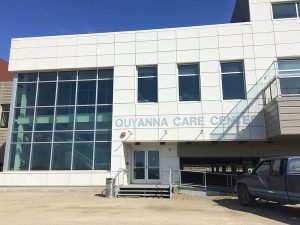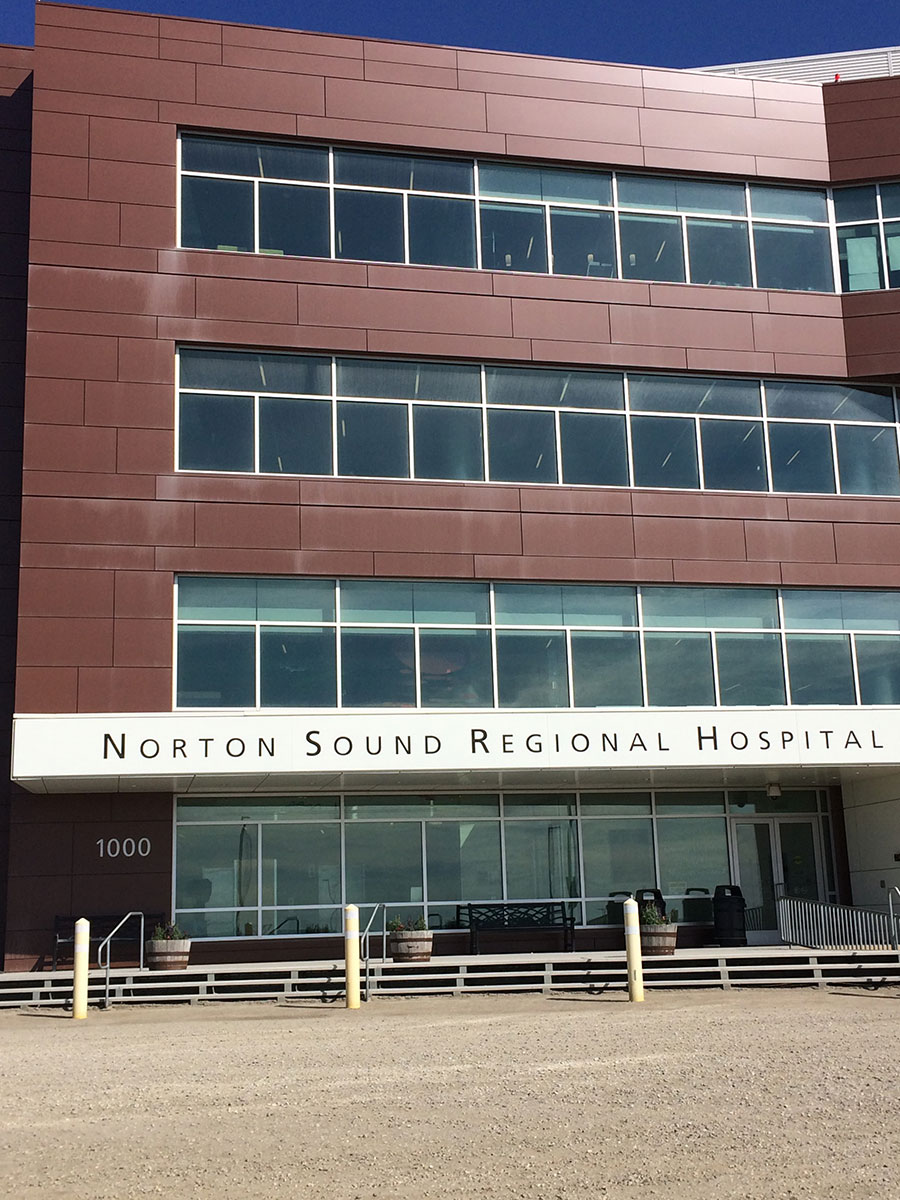

When I first told my parents I was considering pursuing a degree in dietetics, they jokingly thought it implied that I would be spending my days as a lunch lady. While foodservice management is a primary field of dietetics, recently I had the opportunity to experience a week in the life of a clinical dietitian.
The CAMP (Chronic Care Active Management and Prevention) Department in Nome employs three registered dietitians (RDs) and one dietetic technician (DTR). Three of the four of them were actually once Summercise interns just like myself back in 2009, 2014 and 2015! It is inspiring to see professionals in the field who just a few years ago were exactly where I am now. Unfortunately, I do not have many photos to share, as hospital policy prohibits photographs in order to protect patient privacy.
 Attached to the Norton Sound Regional Hospital is the Quyanna Care Center (QCC). This is the only tribal nursing home in the state of Alaska and one of only 14 tribal nursing homes in the nation. Elders are highly respected in this region, and the QCC is able to accommodate 15 residents with round-the-clock attention from registered nurses and certified nursing assistants. The registered dietitian, Pat, is responsible for tracking their dietary evaluations, needs and assessments. This week, I was able to sit down and chat with two patients while observing the percentage of their meal they ate and their ability to chew and swallow. Afterwards, I was able to chart their food and fluid intake, track their weight and write SOAP (Subjective, Objective, Assessment, Plan) notes from my experience. Fortunately, I have previous experience writing SOAP notes for case studies for my Lifespan Nutrition class at UW-Stevens Point. However, there is a bit more pressure when writing them for an actual patient! Pat reviewed the charts and SOAP notes with me, helping to polish things up. Although I have minimal experience working with geriatric patients, as I usually prefer working with kids, I enjoyed this opportunity to learn about what goes into long term care dietary needs.
Attached to the Norton Sound Regional Hospital is the Quyanna Care Center (QCC). This is the only tribal nursing home in the state of Alaska and one of only 14 tribal nursing homes in the nation. Elders are highly respected in this region, and the QCC is able to accommodate 15 residents with round-the-clock attention from registered nurses and certified nursing assistants. The registered dietitian, Pat, is responsible for tracking their dietary evaluations, needs and assessments. This week, I was able to sit down and chat with two patients while observing the percentage of their meal they ate and their ability to chew and swallow. Afterwards, I was able to chart their food and fluid intake, track their weight and write SOAP (Subjective, Objective, Assessment, Plan) notes from my experience. Fortunately, I have previous experience writing SOAP notes for case studies for my Lifespan Nutrition class at UW-Stevens Point. However, there is a bit more pressure when writing them for an actual patient! Pat reviewed the charts and SOAP notes with me, helping to polish things up. Although I have minimal experience working with geriatric patients, as I usually prefer working with kids, I enjoyed this opportunity to learn about what goes into long term care dietary needs.
The CAMP Department offers a free program on Tuesday mornings called Step by Step, in which patients are able to come in for a finger prick screening to learn about their blood lipid and glucose levels. During orientation I was trained how to administer finger prick tests using the glucometer, cholestech LDX and A1c machines. This week I was put to the test! I shadowed another RD, Stephanie, who performed the first patient’s blood tests and consult. She encouraged me to step outside of my comfort zone and left the rest of the patients up to me! I was so nervous with my first patient that I could hardly keep my hand stable enough to plunge the blood I collected from the capillary tube onto the test strip! In general, the people of Nome are extremely patient and kind, and luckily for me, these patients were no different. After my fourth patient, I started to feel confident with the finger pricking procedure, as well the consultation.
With Stephanie in the room for backup, I discussed with the patient their total cholesterol, including the breakdown of LDL and HDL levels, triglycerides, fasting blood sugar, blood pressure and A1c. I have spent the last few weeks learning the optimal, normal and at risk ranges for each of these categories, as I have not yet had any medical nutrition therapy (MNT) classes yet. I felt comfortable discussing nutrition and physical activity lifestyle changes with these patients, as I have prior experience working with student-athletes at UWSP, discussing body composition analysis results with them.
 I was surprised at how educated many of these Nome patients were about their diet and blood test values. Many of them knew the appropriate ranges better than I did! However, they also had many misconceptions, especially about consuming carbohydrates. With diabetes being highly prevalent in this region, many patients are conscious in reducing or even eliminating carbohydrates (CHO) from their diet. However, I advised them not to be afraid of CHO, but rather to choose CHO foods high in fiber, such as brown rice or oatmeal, which will have positive effects on cholesterol and blood glucose levels. A unique circumstance to living in the Norton Sound region is that many of the patients exhibited outstanding HDL levels due to the healthy fats found in native foods such as fish, seal and walrus. Smoking was the biggest obstacle for most of the patients, as it elevates their triglycerides and blood pressure. I assisted in setting up certain patients who desired to reduce or quit smoking with Wanda, the Tobacco Quit Coach in the CAMP Department. As an incentive for participating in the Step By Step program, patients receive a free 5 punch pass or 50% off pass to the Recreation Center, compliments of the CAMP Department.
I was surprised at how educated many of these Nome patients were about their diet and blood test values. Many of them knew the appropriate ranges better than I did! However, they also had many misconceptions, especially about consuming carbohydrates. With diabetes being highly prevalent in this region, many patients are conscious in reducing or even eliminating carbohydrates (CHO) from their diet. However, I advised them not to be afraid of CHO, but rather to choose CHO foods high in fiber, such as brown rice or oatmeal, which will have positive effects on cholesterol and blood glucose levels. A unique circumstance to living in the Norton Sound region is that many of the patients exhibited outstanding HDL levels due to the healthy fats found in native foods such as fish, seal and walrus. Smoking was the biggest obstacle for most of the patients, as it elevates their triglycerides and blood pressure. I assisted in setting up certain patients who desired to reduce or quit smoking with Wanda, the Tobacco Quit Coach in the CAMP Department. As an incentive for participating in the Step By Step program, patients receive a free 5 punch pass or 50% off pass to the Recreation Center, compliments of the CAMP Department.
The rest of the week was spent working in primary care and acute care with yet another RD, Bailey. For in-patient appointments we visited hospital rooms to check patients’ dietary statuses. The fundamental part of this rotation was learning the different therapeutic diets – a meal plan prescribed by a physician or dietitian that controls the intake of certain foods or nutrients. Therapeutic diets are modified for nutrients, texture, and/or food allergies or food intolerance, including clear liquid, full liquid, renal, diabetic, low sodium and feeding tube diets. One morning, I was also able to step in on a swing bed patient. Swing bed patients are those who are in the hospital for several days or even weeks, receiving skilled nursing and rehabilitation services. This patient came in for a hip surgery after a fall likely caused by her undernourishment. When she was admitted last week, she was nearly 60 pounds under her ideal body weight. While she is on a full liquid diet, it is vital that the RD monitors her electrolyte intake (potassium, phosphate and magnesium) as she may be at risk for refeeding syndrome. This syndrome is common in malnourished patients receiving artificial refeeding, and is defined as the potentially fatal shifts in fluid and electrolytes that may result in hormonal and metabolic changes. So yes, I am going to school to be more than just a lunch lady!
I am very grateful for the opportunity to work with various RDs and DTRs this week to experience the various elements involved in clinical dietetics. While each of them had their own niche and style of work, their collaboration is what makes the CAMP department so successful. I appreciate their patience with me, as I became accustomed to the new experiences! Clinical dietetics has never quite been my forte in the past, as I can’t stand the smell, lighting or paper gowns of hospitals. However, I learned ample amounts of useful information that I will be able to apply throughout the rest of my education, dietetic internship and professional work in the near future!
-Jackie
Jackie Braun ’18 is a dietetics major and psychology minor at the University of Wisconsin-Stevens Point.
